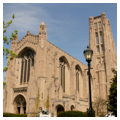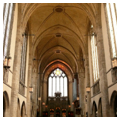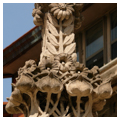Rockefeller Chapel was built on the block east of the University of Chicago quadrangles in 1925–1928 and represents benefactor John D. Rockefeller’s last gift to the university. Goodhue’s chapel design marks an original interpretation of the Gothic Revival style, a blend of both medieval and modern features. The structure features a 207-foot tower, which is set above the northeast transept. The five bays are filled with pastel-colored stained glass windows. Lee Lawrie was responsible for the lavish sculptural program and the vaulted ceiling tiles are by Hildreth Meière, both of whom had worked with Goodhue on the Nebraska Capitol (NE-01-109-0034).
References
Federal Writers Project. The WPA Guide to Illinois. New York: Pantheon Books, 1939.
Harris, Neil. “University of Chicago Campus.” AIA Guide to Chicago. 2nd ed. Orlando, FL: Harcourt, Inc., 2004.
Pridmore, Jay. Building Ideas: An Architectural Guide to the University of Chicago. Chicago: University of Chicago Press, 2013.
Pridmore, Jay. The University of Chicago: An Architectural Tour. New York: Princeton Architectural Press, 2006.





















